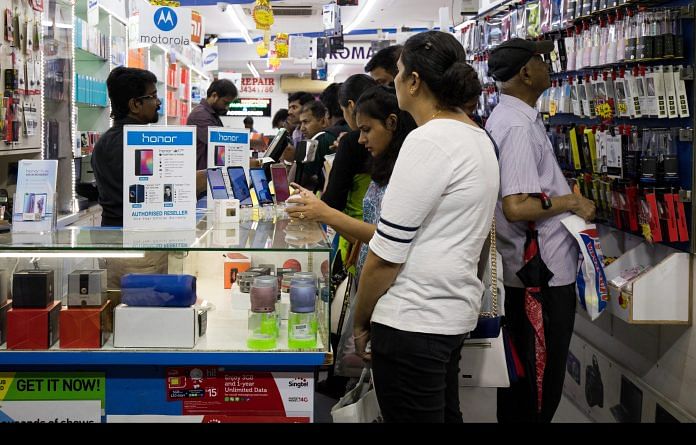Experts say phones are a major chunk, by quantity, of the 2 million MT of e-waste India generates annually.
New Delhi: The Indian obsession with mobile phones is massively contributing to the generation of toxic electronic waste (or e-waste), which is poorly handled and discarded in the country.
India is the second largest smartphone market in the world after China — it has about 650 million total mobile users, as per the telecom analysis firm Counterpoint Research.
Around 40 per cent mobile users replace their phones in less than a year, according to 2017 survey by e-commerce site Quikr Bazaar.
This, experts say, is a major chunk of the over 2 million metric tonnes of electronic waste (or e-waste) India generates annually. “By number or in terms of quantity, mobile phones are the biggest contributors to e-waste,” says Priti Mahesh of environmental NGO Toxics Link.
While Mahesh says that 80 to 85 per cent of a particular discarded mobile phone can be recycled, a majority of this total recyclable e-waste is dangerously handled by the informal sector, with little regulation.
The remaining 15-20 per cent that cannot be recycled, which may include broken glass, crushed plastic and evaporating metallic compounds, end up as landfill or are tossed into nearby drains and waterways, Mahesh says.
Also read : The Japanese model of garbage disposal holds valuable lessons for India
A lucrative sector
The Indian e-waste sector is estimated to be worth $3 billion annually, as per the World Bank Group’s International Finance Corporation.
Apart from mobile phones, the sector is primarily driven by e-waste from discarded desktop computers, cables, printers, refrigerators, air conditioners, televisions, electronic and electrical devices.
While plastics make up 30-40 per cent of the total e-waste by weight, and iron 30-35 per cent, the rest of it is constituted by glass and precious metals, including gold.
Akshay Jain, Managing Director of Namo eWaste Management, says recyclers sell the recovered metals to smelters at global market prices.
According to the Roorkee-based Attero Recycling, a million recycled smartphones yield approximately 16,000 kg of copper, 350 kg of silver, 34 kg of gold and 15 kg of palladium.
Jain says the selling rate for 20 karat gold is about Rs 30,000 per 10 grams, copper is sold between Rs 350 and Rs 500 a kilogram; aluminium for between Rs 90 and Rs 120 a kilogram, while iron is sold for between Rs 20 and Rs 26.
Plastic is sold at cheaper rates, between Rs 2 to Rs 35, based on the quality and grade of the product.
The problem, however, is the methods of extracting such precious metals, which can lead to health hazards such as cancer and respiratory illness. Worse, there seems to be little awareness of the consequences of ill-managed e-waste in the country.
Also read: Eye drops sales have gone through the roof because Indians can’t get enough of smartphones.
Little regulatory oversight
According to Pranshu Singhal, founder of e-waste management solutions provider Karo Sambhav, one in four Indian e-waste handlers in the informal sector suffer from tuberculosis or cancer due to unsafe handling. “Some ways of managing e-waste in the informal sector really are dangerous and hazardous to health,” he said.
Experts say 95 per cent of e-waste is handled by informal sector filled with poor workers who have no other income and are either unaware or can ill-afford to pay heed to the health consequences of mismanaging e-waste.
The workers extract gold and copper from circuit boards by dousing them in open acid baths, which releases more heavy metals, and brominated flame retardants (BFRs). They have little protective gear.
In the informal sector, the circuit boards are taken some distance away from the townships, piled up and burned during the night. The workers come back in the morning to collect the metals.
A 2013 Lancet study found that exposure to e-waste contributed to a number of illnesses. “Most studies showed increases in spontaneous abortions, stillbirths, and premature births, and reduced birth-weights and birth lengths associated with exposure to e-waste,” it said.
“People living in e-waste recycling towns or working in e-waste recycling had evidence of greater DNA damage than did those living in control towns,” it added.
In India, the e-waste hubs are in Delhi’s Seelampur and in Uttar Pradesh’s Moradabad.
The government, however, has taken steps to end the toxic status quo of e-waste in India. It released the E-Waste Management Rules, 2016, which among others, says manufacturers of electrical and electronic equipment must have environmentally friendly and safe plans to manage the e-waste their products may generate. The plan must be first approved and authorised by the Central Pollution Control Board.
Firms cannot sell their electronics and electrical equipment without this authorisation.
Pranshu Singhal of the e-waste management solutions firm, Karo Sambhav, says the rules are a positive step towards reducing the safety hazards in the informal sector.
Also read: No English? No problem. How non-English speakers in India are using their smartphones
Lack of awareness
The other problem, according to NGO Toxics Link, is the general lack of awareness.
A 2015 survey by Toxic Links found that only 50 per cent people interviewed were “acquainted with the term e-waste”. Those interviewed were residents of India’s top 5 e-waste generating cities — Delhi, Mumbai, Chennai, Kolkata and Bengaluru.
“There must be some mechanisms to raise awareness of the health hazards due to harmful material in electronic devices,” says Satish Sinha, associate director at Toxics Link. “Citizens have to start understanding that proper e-waste management means good health.”






